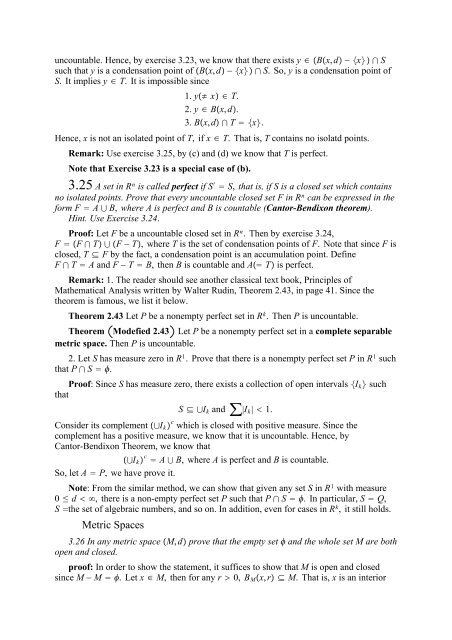The Real And Complex Number Systems
The Real And Complex Number Systems
The Real And Complex Number Systems
You also want an ePaper? Increase the reach of your titles
YUMPU automatically turns print PDFs into web optimized ePapers that Google loves.
uncountable. Hence, by exercise 3.23, we know that there exists y Bx, d x S<br />
such that y is a condensation point of Bx, d x S. So,y is a condensation point of<br />
S. It implies y T. It is impossible since<br />
1. y x T.<br />
2. y Bx, d.<br />
3. Bx, d T x.<br />
Hence, x is not an isolated point of T, ifx T. Thatis,T contains no isolatd points.<br />
Remark: Use exercise 3.25, by (c) and (d) we know that T is perfect.<br />
Note that Exercise 3.23 is a special case of (b).<br />
3.25 AsetinR n is called perfect if S S, that is, if S is a closed set which contains<br />
no isolated points. Prove that every uncountable closed set F in R n canbeexpressedinthe<br />
form F A B, where A is perfect and B is countable (Cantor-Bendixon theorem).<br />
Hint. Use Exercise 3.24.<br />
Proof: Let F be a uncountable closed set in R n . <strong>The</strong>n by exercise 3.24,<br />
F F T F T, whereT is the set of condensation points of F. Note that since F is<br />
closed, T F by the fact, a condensation point is an accumulation point. Define<br />
F T A and F T B, then B is countable and A T is perfect.<br />
Remark: 1. <strong>The</strong> reader should see another classical text book, Principles of<br />
Mathematical Analysis written by Walter Rudin, <strong>The</strong>orem 2.43, in page 41. Since the<br />
theorem is famous, we list it below.<br />
<strong>The</strong>orem 2.43 Let P be a nonempty perfect set in R k . <strong>The</strong>n P is uncountable.<br />
<strong>The</strong>orem Modefied 2.43 Let P be a nonempty perfect set in a complete separable<br />
metric space. <strong>The</strong>n P is uncountable.<br />
2. Let S has measure zero in R 1 . Prove that there is a nonempty perfect set P in R 1 such<br />
that P S .<br />
Proof: SinceS has measure zero, there exists a collection of open intervals I k such<br />
that<br />
S I k and |I k | 1.<br />
Consider its complement I k c which is closed with positive measure. Since the<br />
complement has a positive measure, we know that it is uncountable. Hence, by<br />
Cantor-Bendixon <strong>The</strong>orem, we know that<br />
I k c A B, whereA is perfect and B is countable.<br />
So, let A P, wehaveproveit.<br />
Note: From the similar method, we can show that given any set S in R 1 with measure<br />
0 d , there is a non-empty perfect set P such that P S . In particular, S Q,<br />
S the set of algebraic numbers, and so on. In addition, even for cases in R k , it still holds.<br />
Metric Spaces<br />
3.26 In any metric space M, d prove that the empty set and the whole set M are both<br />
open and closed.<br />
proof: In order to show the statement, it suffices to show that M is open and closed<br />
since M M . Letx M, then for any r 0, B M x, r M. Thatis,x is an interior
















